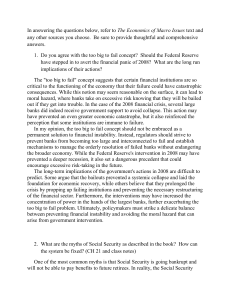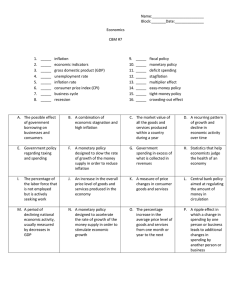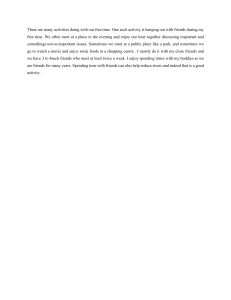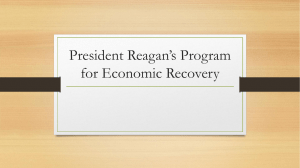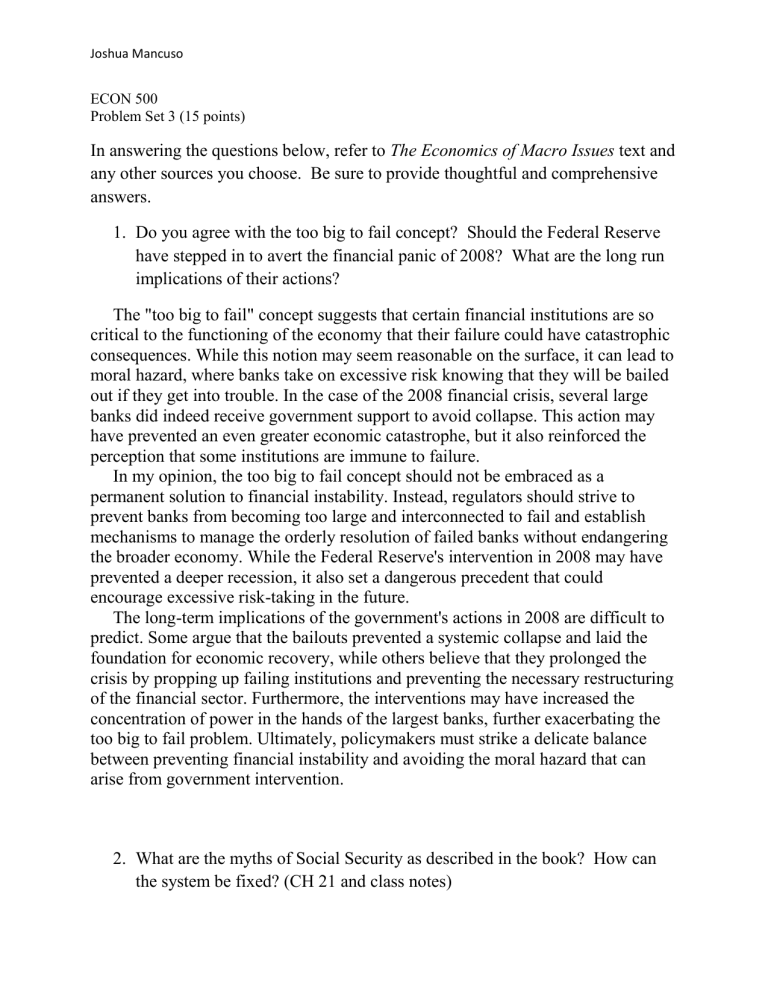
Joshua Mancuso ECON 500 Problem Set 3 (15 points) In answering the questions below, refer to The Economics of Macro Issues text and any other sources you choose. Be sure to provide thoughtful and comprehensive answers. 1. Do you agree with the too big to fail concept? Should the Federal Reserve have stepped in to avert the financial panic of 2008? What are the long run implications of their actions? The "too big to fail" concept suggests that certain financial institutions are so critical to the functioning of the economy that their failure could have catastrophic consequences. While this notion may seem reasonable on the surface, it can lead to moral hazard, where banks take on excessive risk knowing that they will be bailed out if they get into trouble. In the case of the 2008 financial crisis, several large banks did indeed receive government support to avoid collapse. This action may have prevented an even greater economic catastrophe, but it also reinforced the perception that some institutions are immune to failure. In my opinion, the too big to fail concept should not be embraced as a permanent solution to financial instability. Instead, regulators should strive to prevent banks from becoming too large and interconnected to fail and establish mechanisms to manage the orderly resolution of failed banks without endangering the broader economy. While the Federal Reserve's intervention in 2008 may have prevented a deeper recession, it also set a dangerous precedent that could encourage excessive risk-taking in the future. The long-term implications of the government's actions in 2008 are difficult to predict. Some argue that the bailouts prevented a systemic collapse and laid the foundation for economic recovery, while others believe that they prolonged the crisis by propping up failing institutions and preventing the necessary restructuring of the financial sector. Furthermore, the interventions may have increased the concentration of power in the hands of the largest banks, further exacerbating the too big to fail problem. Ultimately, policymakers must strike a delicate balance between preventing financial instability and avoiding the moral hazard that can arise from government intervention. 2. What are the myths of Social Security as described in the book? How can the system be fixed? (CH 21 and class notes) Joshua Mancuso One of the most common myths is that Social Security is going bankrupt and will not be able to pay benefits to future retirees. In reality, the Social Security Trust Fund currently has sufficient assets to pay full benefits until 2033, and even after that, it would still be able to pay roughly 75% of benefits. Another myth is that Social Security is a Ponzi scheme, where current workers pay into the system to support current retirees, and future workers will pay into the system to support them when they retire. While this may seem like a pyramid scheme, Social Security is funded by payroll taxes and has a legal framework that makes it distinct from a Ponzi scheme To fix the Social Security system, policymakers have proposed various solutions, including raising the retirement age, increasing payroll taxes, and reducing benefits for high-income earners. However, these proposals are politically challenging and may be insufficient to address the long-term financial sustainability of the system. A more comprehensive solution would involve a combination of policy changes, such as adjusting the inflation index used to calculate benefit increases and expanding Social Security coverage to more workers, as well as measures to increase economic growth and workforce participation. Policymakers could also explore alternative sources of revenue, such as a financial transaction tax or a carbon tax, to fund the system. Ultimately, fixing the Social Security system will require a combination of political will and creative policy solutions to ensure that future generations of retirees can receive the benefits they deserve. 3. Why are healthcare costs so high in this country? What is the problem of adverse selection and moral hazard as it relates to the Affordable Care Act? (CH 17 and class notes) Healthcare costs are high in the United States for several reasons. One major factor is the high cost of medical technology and prescription drugs, which are often more expensive in the US than in other countries due to factors such as patent protection and regulatory barriers. Another contributing factor is the fee-forservice payment system, which incentivizes providers to order more tests and procedures rather than focusing on preventive care or managing chronic conditions. In addition, the fragmented nature of the healthcare system and the lack of price transparency make it difficult for consumers to shop around for the best value. The problem of adverse selection and moral hazard is a key challenge for the Affordable Care Act (ACA). Adverse selection occurs when people who are most likely to need healthcare sign up for insurance, while healthy people opt out. This Joshua Mancuso can lead to higher premiums and reduced coverage for those who remain in the insurance pool. Moral hazard occurs when people with insurance overuse healthcare services because they are not paying the full cost, leading to higher healthcare costs overall. The ACA attempts to address these problems through measures such as the individual mandate, which requires most people to have health insurance, and subsidies to make insurance more affordable for low-income individuals. However, the effectiveness of these measures depends on factors such as the cost of insurance and the availability of providers in each market. As the healthcare system continues to evolve, policymakers will need to address the challenge of balancing access to care with cost control. 4. What is more effective at generating economic growth, a tax rebate (stimulus payments) or a decrease in the tax rate? Why? The effectiveness of a tax rebate versus a decrease in the tax rate at generating economic growth depends on several factors. In general, a decrease in the tax rate may have a more sustained impact on economic growth, as it provides a permanent reduction in the cost of labor and capital. This can lead to increased investment, job creation, and productivity, which can drive long-term economic growth. On the other hand, a tax rebate or stimulus payment may have a more immediate impact on consumer spending, as people have more disposable income to spend on goods and services. This can stimulate short-term demand and may be useful in addressing a temporary economic downturn. However, the effectiveness of these policies also depends on how they are implemented and how they are financed. For example, a tax cut that is not accompanied by spending cuts or revenue increases may lead to increased government debt and higher interest rates, which can offset the positive impact on economic growth. Similarly, a tax rebate that is funded by increased government borrowing may lead to higher interest rates and crowding out of private investment, which can also dampen economic growth. Overall, the effectiveness of tax policies at generating economic growth depends on a complex interplay of factors, and policymakers must carefully consider the trade-offs involved in each approach. 5. How does the government finance increased spending? Depending on how financed, what are the long run economic effects? Joshua Mancuso The government can finance increased spending through borrowing, printing money, and raising taxes. Each of these methods has different implications for the economy. Borrowing can lead to an increase in government debt, which may reduce the government's ability to invest in the future and can lead to higher interest rates that can crowd out private investment. Printing money can cause inflation, which reduces the value of money and can lead to higher interest rates, lower investment, and reduced economic growth. Raising taxes can reduce disposable income and discourage investment and entrepreneurship, but it can also help to reduce government debt and improve the sustainability of government spending. The long-run economic effects of financing increased spending depend on how the spending is financed. If the spending is financed through borrowing or printing money, it can lead to higher inflation, higher interest rates, and reduced economic growth over the long term. On the other hand, financing increased spending through raising taxes can have a positive effect on the economy over the long term by reducing the burden of government debt and improving the sustainability of government spending. Ultimately, the choice of how to finance increased spending should consider the short-term and long-term implications for the economy, as well as the distributional effects of each option. 6. What is moral hazard as it relates to the “Too Big to Fail” concept? How does this philosophy prevent creative destruction? Moral hazard refers to the tendency of individuals or institutions to take on greater risks when they are insulated from the potential consequences of those risks. In the context of the "Too Big to Fail" concept, moral hazard arises when large financial institutions are perceived as being guaranteed a government bailout in the event of a crisis. This can lead these institutions to take on excessive risk, as they do not bear the full costs of their actions. In turn, this can lead to a situation where these institutions become "Too Big to Fail," as their failure would have systemic implications for the entire financial system. This can prevent creative destruction, which is the process of inefficient firms being replaced by more efficient ones, as large firms may be shielded from the consequences of their actions, making it difficult for smaller, more efficient firms to compete on a level playing field. Joshua Mancuso 7. How has the Fed’s implementation of monetary policy changed in recent years? What are the implications of this change? In recent years, the Federal Reserve has implemented a more aggressive monetary policy in response to the 2008 financial crisis. This has included lowering interest rates to near zero, engaging in large-scale asset purchases through quantitative easing, and shifting towards forward guidance. The Fed has also taken a more proactive role in financial regulation, particularly with respect to systemic risk. The implications of these changes are complex, with potential benefits for economic growth and financial stability, but also concerns about inflation, financial imbalances, and the politicization of monetary policy. Overall, the changes reflect a desire to more effectively manage the challenges of a rapidly changing economic environment. 8. What is the downside, even with a fully functional digital wallet system in place, of never carrying any cash with you? (CH 25) One downside of never carrying any cash with you, even with a fully functional digital wallet system in place, is the potential for technological failures or disruptions. A digital wallet relies on electronic systems to process transactions, which can be vulnerable to hacking, glitches, or other forms of technical malfunctions. This can lead to situations where individuals are unable to access their funds or make purchases, particularly in areas with limited or unreliable internet connectivity. Additionally, reliance on digital payment systems may lead to issues with privacy and security, as personal financial information is stored and transmitted electronically. In sum, while digital wallet systems offer convenience and efficiency, they are not foolproof and may present certain risks and challenges that should be considered. 9. Briefly discuss the use of fiscal policy verses monetary policy as a means of smoothing economic cycles. Fiscal policy and monetary policy are two tools that governments use to smooth economic cycles. Fiscal policy involves changes in government spending and taxation, while monetary policy involves changes in interest rates and the money supply. Fiscal policy can be used to directly affect aggregate demand, through changes in government spending and taxation, and can be targeted to specific Joshua Mancuso sectors or groups. However, fiscal policy can be slow to implement and subject to political constraints. In contrast, monetary policy can be implemented quickly and is generally free from political influence, but may be less effective in targeting specific sectors or groups. Ultimately, the effectiveness of each policy tool depends on the specific economic context and the goals of policymakers. A combination of both fiscal and monetary policy may be most effective in smoothing economic cycles and achieving desired outcomes.
